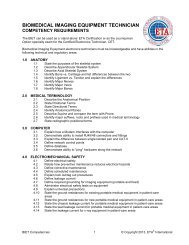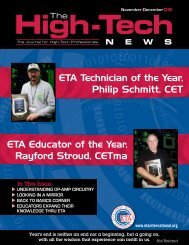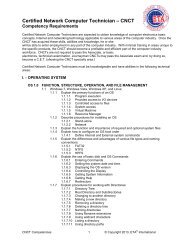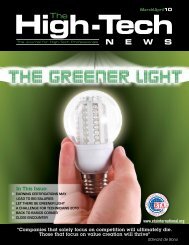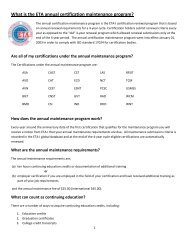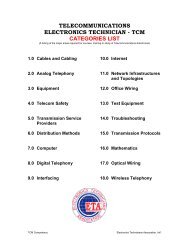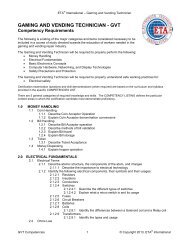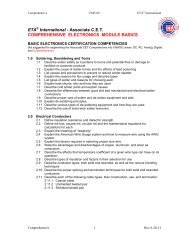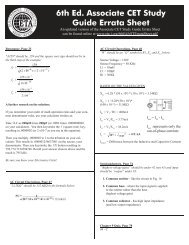fiber optics technician â outside plant (fot-osp) - ETA International
fiber optics technician â outside plant (fot-osp) - ETA International
fiber optics technician â outside plant (fot-osp) - ETA International
Create successful ePaper yourself
Turn your PDF publications into a flip-book with our unique Google optimized e-Paper software.
Fiber Optics Technician – Outside Plant Knowledge Competencies10.10 Explain why a mid-entry into an OSP cable may be required10.11 Explain the tension ratings of drop and trunk cables10.12 List the minimum depth for burial of a <strong>fiber</strong> optic cable drop10.13 Name cable management products used for cable slack in aerial installations10.14 Name cable management products used for slack cable in hubs and vaults10.15 List the maximum tension level for a <strong>fiber</strong> optic drop cable11.0 HARDWARE11.1 Explain common practices for <strong>fiber</strong> optic splice closures11.2 Explain the role of the Fiber Distribution Unit (FDU)11.3 Explain the role of the Fiber Distribution Hub (FDH) in FTTx applications11.4 Explain the role of the Fiber Access Terminal (FAT) in FTTx applications11.5 Explain the role of the Multiport Service Terminal (MST) in FTTx applications11.6 Describe how the mid-entry splice cables are routed through a splice enclosure11.7 Describe the different types of cable management products that are used at the hub locations11.8 Compare the options for cable routing in a hub location11.9 Explain the NEC ® requirement for outdoor cable entry into a building11.10 List the different types of innerduct products commonly used in <strong>fiber</strong> optic cabling11.11 Describe how a loose tube cable is installed and spliced at an entrance cabinet11.12 Describe the products, applications and options used in the Optical Distribution Network (ODN) forFTTx installations11.13 Describe the five installation/termination options for the FTTx drop cables12.0 FIBER OPTIC LINK12.1 List the three basic parts of a <strong>fiber</strong> <strong>optics</strong> system12.2 Explain how to prepare a basic optical link power budget12.3 Explain the purpose of a basic “not to exceed” OSP loss budget12.4 Explain how to measure the receive power levels of a <strong>fiber</strong> <strong>optics</strong> receiver12.5 Describe how to use an optical attenuator and calculate the proper reduction of signal output lightintensity12.6 Describe the topologies used in MAN applications12.7 Describe the topology used in an FTTx installation13.0 OPTICAL FIBER MEASUREMENT AND TESTING13.1 List the types of attenuation in <strong>fiber</strong> <strong>optics</strong> cables13.2 Explain how to properly use an Optical Loss Test Set13.3 Explain when 2 KHz modulation of the <strong>fiber</strong> optic light source would be used13.4 Explain the proper use of the <strong>fiber</strong> optic power meter (OPM)13.5 Describe how to locate a fault using an Optical Time Domain Reflectometer (OTDR)13.6 Compare fusion and mechanical splice, connector, and splitter signatures when using the OTDR13.7 Describe a micro/macrobend at a splice closure13.8 Describe the ‘Fiber Identifier’ and its operation13.9 Explain how to measure Fresnel reflections at patch panels13.10 Explain why bi-directional tests are performed13.11 Explain the reasons for dual wavelength testing13.12 Explain when to test using a light source and power meter13.13 Explain what tests the OTDR is used for13.14 Describe the causes of ghost reflections13.15 Explain how the <strong>fiber</strong> optic talk set is used13.16 Describe when and where the visual laser is commonly used14.0 LINK AND CABLE TESTING14.1 Explain why an end-to-end optical loss test is performed14.2 Describe the transmitter power test using the optical power meter14.3 Describe the receiver optical power test using the optical power meter14.4 Explain the purpose of an acceptance test to verify <strong>fiber</strong> optic cable values using an OTDR14.5 Explain how an acceptance test for a mechanical splice is made14.6 Describe the OTDR’s ‘dead zone’FOT-OSP Competencies 4 © Copyright 2014, <strong>ETA</strong> ® <strong>International</strong>



